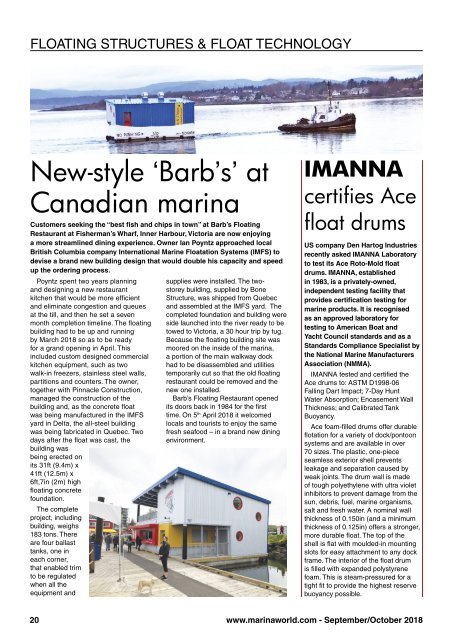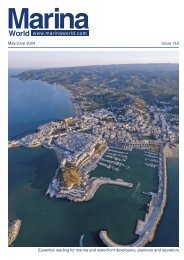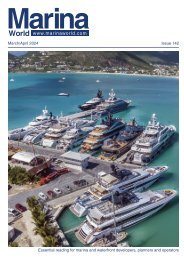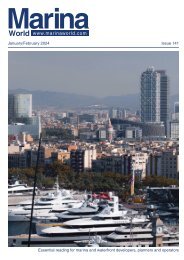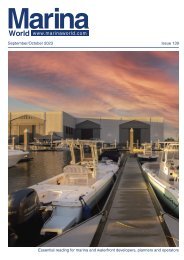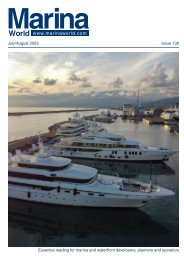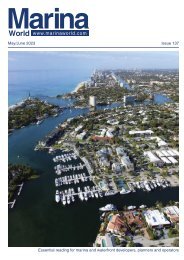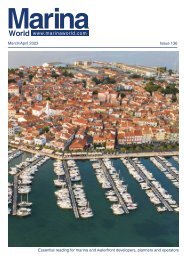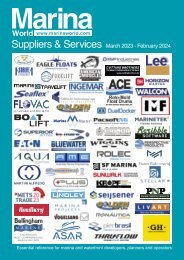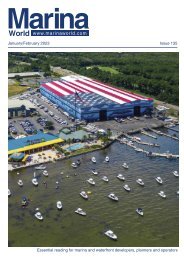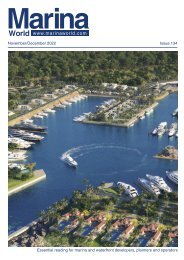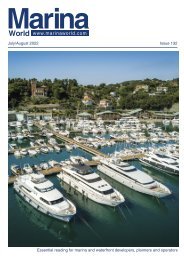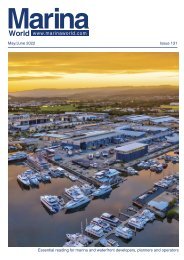2018 September October Marina World
The magazine for the marina industry
The magazine for the marina industry
You also want an ePaper? Increase the reach of your titles
YUMPU automatically turns print PDFs into web optimized ePapers that Google loves.
FLOATING STRUCTURES & FLOAT TECHNOLOGY<br />
New-style ‘Barb’s’ at<br />
Canadian marina<br />
Customers seeking the “best fish and chips in town” at Barb’s Floating<br />
Restaurant at Fisherman’s Wharf, Inner Harbour, Victoria are now enjoying<br />
a more streamlined dining experience. Owner Ian Poyntz approached local<br />
British Columbia company International Marine Floatation Systems (IMFS) to<br />
devise a brand new building design that would double his capacity and speed<br />
up the ordering process.<br />
Poyntz spent two years planning<br />
and designing a new restaurant<br />
kitchen that would be more efficient<br />
and eliminate congestion and queues<br />
at the till, and then he set a seven<br />
month completion timeline. The floating<br />
building had to be up and running<br />
by March <strong>2018</strong> so as to be ready<br />
for a grand opening in April. This<br />
included custom designed commercial<br />
kitchen equipment, such as two<br />
walk-in freezers, stainless steel walls,<br />
partitions and counters. The owner,<br />
together with Pinnacle Construction,<br />
managed the construction of the<br />
building and, as the concrete float<br />
was being manufactured in the IMFS<br />
yard in Delta, the all-steel building<br />
was being fabricated in Quebec. Two<br />
days after the float was cast, the<br />
building was<br />
being erected on<br />
its 31ft (9.4m) x<br />
41ft (12.5m) x<br />
6ft,7in (2m) high<br />
floating concrete<br />
foundation.<br />
The complete<br />
project, including<br />
building, weighs<br />
183 tons. There<br />
are four ballast<br />
tanks, one in<br />
each corner,<br />
that enabled trim<br />
to be regulated<br />
when all the<br />
equipment and<br />
supplies were installed. The twostorey<br />
building, supplied by Bone<br />
Structure, was shipped from Quebec<br />
and assembled at the IMFS yard. The<br />
completed foundation and building were<br />
side launched into the river ready to be<br />
towed to Victoria, a 30 hour trip by tug.<br />
Because the floating building site was<br />
moored on the inside of the marina,<br />
a portion of the main walkway dock<br />
had to be disassembled and utilities<br />
temporarily cut so that the old floating<br />
restaurant could be removed and the<br />
new one installed.<br />
Barb’s Floating Restaurant opened<br />
its doors back in 1984 for the first<br />
time. On 5 th April <strong>2018</strong> it welcomed<br />
locals and tourists to enjoy the same<br />
fresh seafood – in a brand new dining<br />
environment.<br />
IMANNA<br />
certifies Ace<br />
float drums<br />
US company Den Hartog Industries<br />
recently asked IMANNA Laboratory<br />
to test its Ace Roto-Mold float<br />
drums. IMANNA, established<br />
in 1983, is a privately-owned,<br />
independent testing facility that<br />
provides certification testing for<br />
marine products. It is recognised<br />
as an approved laboratory for<br />
testing to American Boat and<br />
Yacht Council standards and as a<br />
Standards Compliance Specialist by<br />
the National Marine Manufacturers<br />
Association (NMMA).<br />
IMANNA tested and certified the<br />
Ace drums to: ASTM D1998-06<br />
Falling Dart Impact; 7-Day Hunt<br />
Water Absorption; Encasement Wall<br />
Thickness; and Calibrated Tank<br />
Buoyancy.<br />
Ace foam-filled drums offer durable<br />
flotation for a variety of dock/pontoon<br />
systems and are available in over<br />
70 sizes. The plastic, one-piece<br />
seamless exterior shell prevents<br />
leakage and separation caused by<br />
weak joints. The drum wall is made<br />
of tough polyethylene with ultra violet<br />
inhibitors to prevent damage from the<br />
sun, debris, fuel, marine organisms,<br />
salt and fresh water. A nominal wall<br />
thickness of 0.150in (and a minimum<br />
thickness of 0.125in) offers a stronger,<br />
more durable float. The top of the<br />
shell is flat with moulded-in mounting<br />
slots for easy attachment to any dock<br />
frame. The interior of the float drum<br />
is filled with expanded polystyrene<br />
foam. This is steam-pressured for a<br />
tight fit to provide the highest reserve<br />
buoyancy possible.<br />
20<br />
www.marinaworld.com - <strong>September</strong>/<strong>October</strong> <strong>2018</strong>


